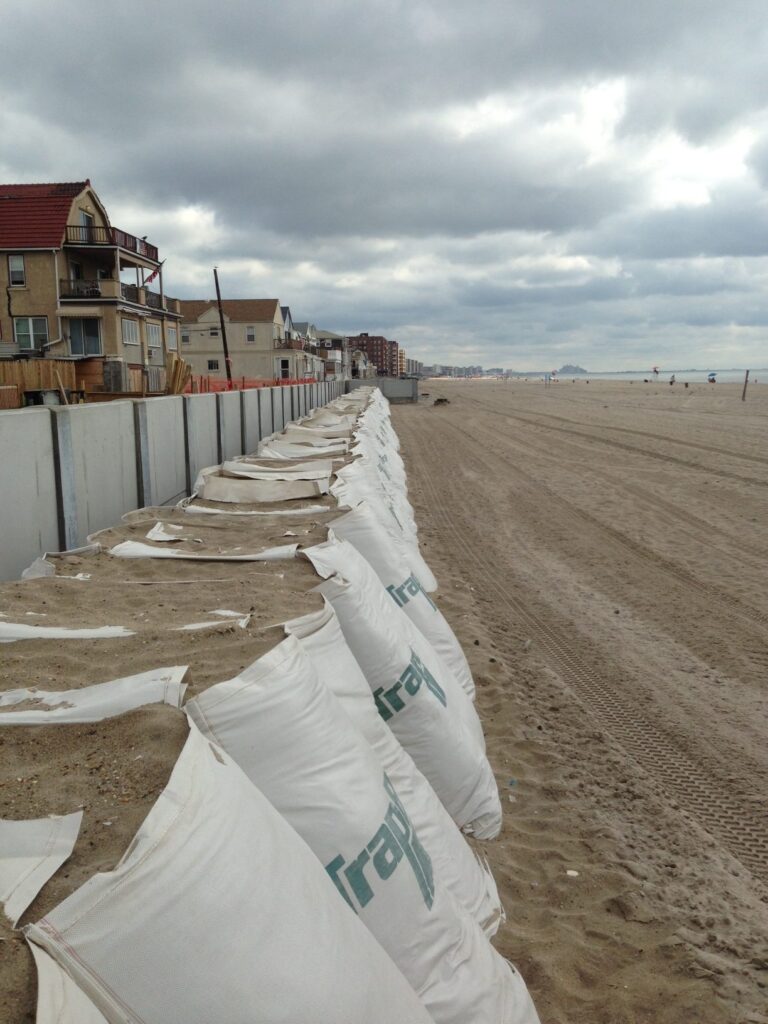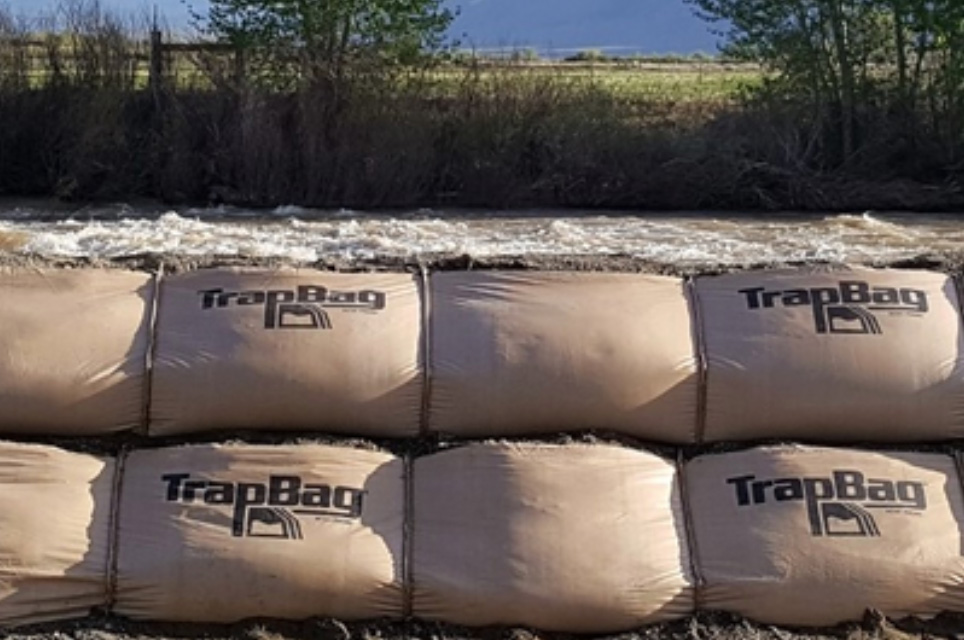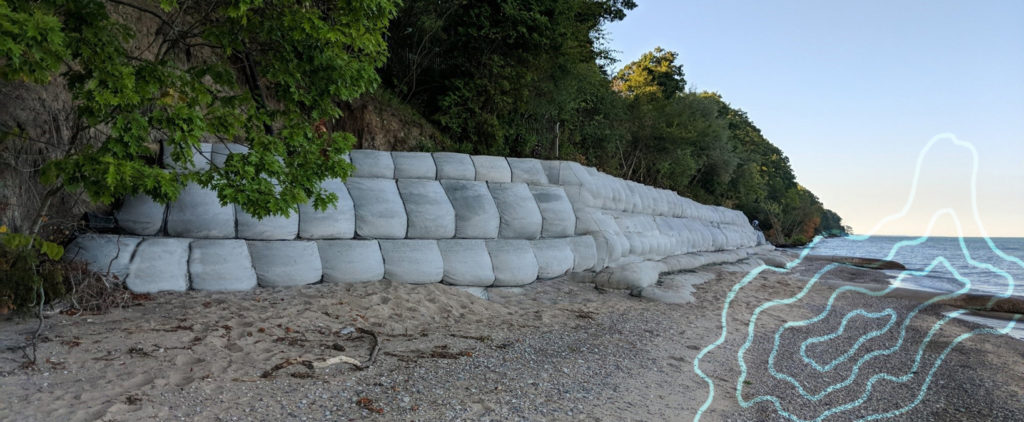How to Use TrapBag® Barriers as a Sheet Pile Alternative
TrapBag barriers are superior to traditional metal sheet piles for construction retaining walls due to their versatility and ease of installation.

TrapBags as a Metal Sheet Piling Alternative
Metal sheet piling is often used in a variety of construction projects, providing support to the surrounding soil or retaining disturbed ground and water during the excavation process. The method of utilizing metal sheet piling in these scenarios is not the optimal answer; it is often laborious to install, as more power is required for ground penetration, whether that be loud and disruptive vibratory hammers or hydraulics.
There is, however, a superior alternative to sheet piling: TrapBag® barriers. Due to their versatility, ease of use and storage, and engineered longevity, TrapBags are a much better solution on construction sites where a retaining wall or protective blockade is required, including:
- Sheet pile cofferdam construction: Intended to contain water and earth during excavation, reparation, and construction of a bridge, pier, or another subsurface site, TrapBags can be efficiently deployed to allow for safe, timely erection.
- Sheet pile seawall construction: In order to delay and prevent the effects of erosion on water-adjacent land, a seawall of TrapBags can be rapidly deployed and added upon to reach a necessary height. This method beats that of a metal sheet pile, which often needs to penetrate difficult terrain before becoming effective.
- Sheet pile retaining walls for excavation projects: Made to prevent soil loss during a project that involves digging, TrapBag barriers make excellent retaining walls due to their ease of deployment and removal.
Advantages of TrapBags
When it comes to retaining earth and water by providing temporary or permanent walls for construction, TrapBags have many benefits, including:
- A variety of sizes to help fit project needs, whether that be a residential or commercial building, bridge or pier, retaining wall or seawall, dams, dikes, or levees
- Interconnected, accordion-style structure is similar to the interlocking mechanism of standard metal sheet piling, creating sturdy, leak-proof, reliable barriers
- The uniquely engineered pentagon shape makes them incredibly strong, able to withstand damaging flood waters
- Highly durable textile ensures strength and reliability when you need it most, and unlike certain forms of metal sheet piling, is not affected by potentially corrosive factors like seawater or run-off carried pollutants
- Easy and quick to set up, take down, and store when not in use as a result of the interconnected design and ability to remove sand or washed rock filling
- Due to ground penetration not being necessary, TrapBags are much easier and less damaging to install in difficult, rocky soil, as opposed to metal sheet piling which can be difficult to insert and destructive when forced into the ground
Cofferdam Construction with TrapBags
TrapBags can be used to create temporary cofferdams on water-based construction projects in lieu of sheet piling, for structures like bridges and piers. Unlike the rigid confines of metal sheet piling, TrapBags can allow for any water-tight configuration or shape to be made easily and without disrupting the inner earth underneath the structure.
Seawall Construction with TrapBags
TrapBags can be used to build permanent seawalls and aid in other shoreline barrier applications to prevent flooding and erosion. The benefits of using TrapBags instead of metal sheet piles for seawalls are illustrated in:
- Erosion barriers: While metal sheet piling requires force to drive it into the earth, potentially causing instability, TrapBags can be easily deployed on and around an area to prevent flooding and erosion in a way that protects the integrity of the soil, sand, or rock.
- Dams/dikes/levees: TrapBag barriers are an efficient method of flood control, and can be rapidly arranged in a variety of configurations to provide protection for whatever the situation needs, whether that be acting as a temporary dam in water logged sites, or protecting necessary road ways, agricultural plots, or commercial or residential spaces from overflowing water.
Retaining Wall Construction with TrapBags
TrapBag barriers can be used to create sturdy mechanically stabilized earth (MSE) retaining walls as well as gravity walls and mudslide retention walls, proving useful in an array of construction applications. The benefits of using TrapBags as an alternative to sheet piling can be seen in:
- Excavation projects: The solid, interconnected design of TrapBags make them adept at retaining earth during precarious excavation work. TrapBags come in a variety of layouts to adapt to any ground shape.
- Reinforce foundations: Post-construction and pre move-in, the ground upon which the structure is placed requires additional stabilization to ensure it provides a safe, strong foundation. TrapBag barriers can be stacked accordingly to supply a steady, long-lasting strengthening solution. As TrapBag barriers can be filled with a variety of either sand, washed rock, or concrete, they are able to properly adhere to the terrain on your property.
- Cave-in protection on confined construction projects: Whereas metal sheet piling takes more time and effort to be inserted into the ground, TrapBags provide a time-sensitive solution to sites with confined construction areas that require reliable worker protection from cave-ins and minimization of soil degradation.
Take the Next Step
Ready to experience the durability and longevity of TrapBags as a sheet pile alternative for your next construction project? To provide a secure, easy to deploy, reliable temporary or permanent barrier of TrapBags to your site, send us a message today.
Get the Dirt Before the Flood Hits
Stay ahead of flooding, erosion, and disaster response challenges. The Dirt, TrapBag’s monthly newsletter, delivers field-tested tips, real-world case studies, and the latest in barrier technology straight to your inbox.


